Kitchen Project #84: Pear & walnut meringue gâteau
With JR Ryall, author of 'Ballymaloe Desserts'
Hello and welcome to today’s edition of Kitchen Projects! Thank you so much for being here.
Today we’ll be diving into the world of JR Ryall, head pastry chef of Ballymaloe House and author of ‘Ballymaloe Desserts.’ We’ll begin by delving into JR’s wonderful story before getting deep into one of the recipes from his book: A Pear and WWalnut Meringue Gâteau. Over on KP+, I have the pleasure of sharing JR’s recipe for ‘dangerously long’ Langues de chat, an ultra buttery biscuit that would complete any dessert. Click here for the recipe.
Kitchen Projects is 100% reader funded; By joining KP+, you will support the writing and research that goes into the newsletter and get access to extra content, community chat threads, and more. Subscribing is easy and only costs £5 per month:
Alright, let’s do it!
Love,
Nicola
The meaning of dessert
I’m forever fascinated with the wide approach to desserts out there and love nothing more than diving into a new pastry book. I’m especially happy when I find one as thoughtful, beautiful and elegant as the truly divine ‘Ballymaloe Desserts.’ Despite the huge numbers of books coming out every year, this one feels rare, a book to be savoured.
Friends, today I have the absolute pleasure of introducing you to JR Ryall, head pastry chef of Ballymaloe House and author of the aforementioned ‘Ballymaloe Desserts’ published last week. Filled with delights like hot lemon pudding, honey mousse with lavender jelly, almond praline cake, saffron poached pears and apple and blackberry tarts, I can confidently say this is a modern classic that belongs in any pastry lover’s kitchen. I sat down with JR (digitally) to learn more about the journey that led him here today.
“I've spent the last decade trying to understand pears!” JR tells me. “We've over 11 different varieties at Ballymaloe and they have to be picked on different weeks, depending on the variety.” From those mercurial pears to peaches, rhubarb to berries, apples to plums, JR’s pastry kitchen works harmoniously with the Ballymaloe organic farm throughout the year, allowing for extraordinary precision when harvesting. “I’ll watch a particular tree and think, ‘I'll keep a close eye on those plums now!’ for Thursday’s menu. But then the weather [isn’t] warm enough and you know they're not going to be ready ‘til Sunday.”
Ballymalloe House (pronounced Ballyma-LOO ie. rhymes with shoe, in case you were wondering) is located in County Cork, Ireland. In 1964 Myrtle Allen opened the doors of her home, a country house on their family farm. With a strong belief in the excellence of Irish ingredients, Ballymaloe House (then called ‘The Yeats Room’ after the art displayed) served a daily changing menu that reflected the seasons and focused on freshness and simplicity. Most importantly, the offering was deeply rooted in its relationship with the farm and other local suppliers.
Listening to JR’s story, I can’t help but feel there’s a smidge of fate at play. “So as long as I can remember tasting things has been very important to me” JR tells me. “It was like this innate curiosity that’s underpinned most of the decisions I made in my life, actually.”
Naturally, his earliest memory is related to food. When JR was just four years old his aunt, who worked at the Ballymaloe Cookery School (opened 1983) located just down the road from the restaurant, brought him on a tour of the school, farm and gardens. At the end, he met the famed chef / author Darina Allen, co-founder of the school and daughter-in-law of Myrtle Allen, who signed a copy of her book ‘Simply Delicious’. It said, “For JR, who will be a great chef when he grows up. Love from Darina Allen, March 1992.” And so the chain reaction began. “You don't realise what things are going to be formative until you're in the future and you look back. But that day was very formative for me.”
Of course, fate is useless without natural talent or a strong will to back it up - fortunately for us, JR has both in buckets. “I was the kid who cooked! And it wasn't really cool for kids to cook then” he explains, “it was mostly pastry, you know, cookies and cakes. Because when you’re six, no one hands you a leg of lamb.” And, with the encouragement of family and friends backing up this inherent ability, his interest continued to grow. And grow.
At 13, JR stepped into a kitchen for the first time. A gift from his mother, “it was a two and a half day course at the cookery school, and it opened a door into the world of what kitchens were actually about.” During the course he was introduced to the Ballymaloe way, once again visiting the farm and discovering ingredients he would never have had access to at home. He had a realisation that if he “could spend some time in Ballymalloe, I'd really be able to satisfy this itch that I had.”
So, the following year, JR returned to Ballymaloe for work experience. Here, he met Myrtle Allen, or Mrs. Allen as she is affectionately referred to throughout our conversation and in JR’s book. “That was the day my life changed” he says. “She literally dazzled me. I don't know how often in someone's life they get dazzled by somebody but I was immediately captivated.”
I’m not surprised. JR goes on to tell me extraordinary stories about Myrtle Allen that dazzle me, too. From being able to tell the difference between butter from cows who grazed in different fields (“It blows my mind that a farmer's wife in the 1970s would notice that butter is better one week to the next.”), to her extremely precise scaling of sandwiches (“She would work out exactly how much salt, pepper and butter to mash with that egg, how much wild watercress to chop … And then she’d say ‘Ok, get 73 eggs, 15 handfuls of wild watercress…’ and you’d make just enough ... And, of course, they’re the most delicious sandwiches anyone ever ate, without one to spare!”) to her split decision to open an Irish restaurant in Paris in the 80s (“[The owner of the building] got in touch with Myrtle and said ‘we'd love someone Irish to either run a restaurant in this building or we're gonna sell it … 3 days later she rings back and says ‘We’ll take it.’ …. They packed up sacks of wholemeal flour for soda bread, blocks of Irish cheese, sides of smoked salmon, Irish bacon, blood puddings, all the things we love, carrageenan moss for set pudding. And she filled the van with chefs and they drove to Paris and they opened a restaurant!”), it's abundantly clear just how formidable and radical Myrtle Allen was.
To put it into context, Myrtle Allen, married to farmer Ivan Allen, opened Ballymaloe House in 1964, long before ‘farm to table’ existed (for further context, Chez Panisse opened in California in 1971). Having no restaurant experience, Mrs Allen “was led by instinct and her instinct was solid.” JR explains “This idea that restaurants would have intimate relationships with farms, nevermind being located on a farm, nevermind a farmer opening a restaurant. You know, none of this had really happened.” It was rare, too, at the time to open private homes to the public and the Allen’s risked stigma from the locals. But Mrs Allen stuck to her instinct, her “North Star” as JR describes it. “Every decision she made was to get closer to that star.”
Editor's note: Before speaking with JR, I knew a little bit about Ballymaloe and Myrtle Allen, this magnificent matriach, but I don’t think I understood the magnitude of her influence. During her life and after her passing, at the age of 94 in 2018, she was rightly credited for modernising Irish cooking. But I am surprised that her name and work don’t seem to be as instantly recognisable as other chefs who champion farming, like Simon Rogan, the Coombeshead Farm team, Alice Waters or Dan Barber. From hearing her story from JR and the myriad of ways she has influenced him and so many others, I was reminded that a commitment to sourcing selectively and locally is not a small story - it has global significance! Support your local greengrocer and farm, if you can! And if in doubt about whether to buy those out of season berries, just think, what would Mrs Allen do?!
After meeting, and falling for, Mrs Allen’s philosophy and vision, JR enthusiastically continued his work experience at Ballymaloe House. It was a warm place that “ran like a family farm”, where “we all got treated like real people.” This stint led to a paid Saturday job in the kitchen and, after completing his Natural Sciences degree at Trinity College in Dublin (whilst still returning to Ballymaloe for the summers and to work particularly busy periods, of course), Mrs Allen offered JR the role of Head Pastry Chef. He was just 21 years old, and he accepted, happily.
It’s been over a decade since JR took the helm of the pastry kitchen, the very place where he truly learned “how to taste.” Here, along with a small team of chefs, he artfully balances the daily changing dessert selection which, I am thrilled to tell you, is presented to diners on a trolley. From “warm puddings served spoon by spoon”, to “whole gâteau pithiviers”, to “ice bowls filled with ice cream”, it changes daily. And the best thing? You can try them all. This approach means “small amounts of produce can be incorporated into a single dish for a single night” so “nothing goes to waste.” And I’m thrilled when JR tells me - reassuringly - “If people want more, it's there. The trolley can come back!”
JR and his team, spurned on by Mrs Allen’s philosophy, are always “making sure every bit of everything gets used as best we can.” He also incorporates inspiration from his travels with annual trips to stage in kitchens and bakeries around the world, from San Francisco (Tartine and Chez Panisse, no less) to adventures in China, Hawaii, Mexico and Japan.
JR’s trolley, by the way, is award-winning. In 2019, he was flown to Paris to receive the ‘Trolley of the Year Award’ at the Resturant Awards (“I thought it must be a joke, one of my friends is having a great laugh somewhere!” It wasn’t!). As fabulous as that is, it’s his passion for the day-to-day that sets JR apart, his dedication to act as the thread that connects the rich history of Mrs Allen’s Ballymaloe with the present day. “The recipes we use today, we have been using for over half a century. And by putting versions of classic recipes that I enjoy the most next to a newer generation, I hope to breathe life into some older dishes that are so easily overlooked.”
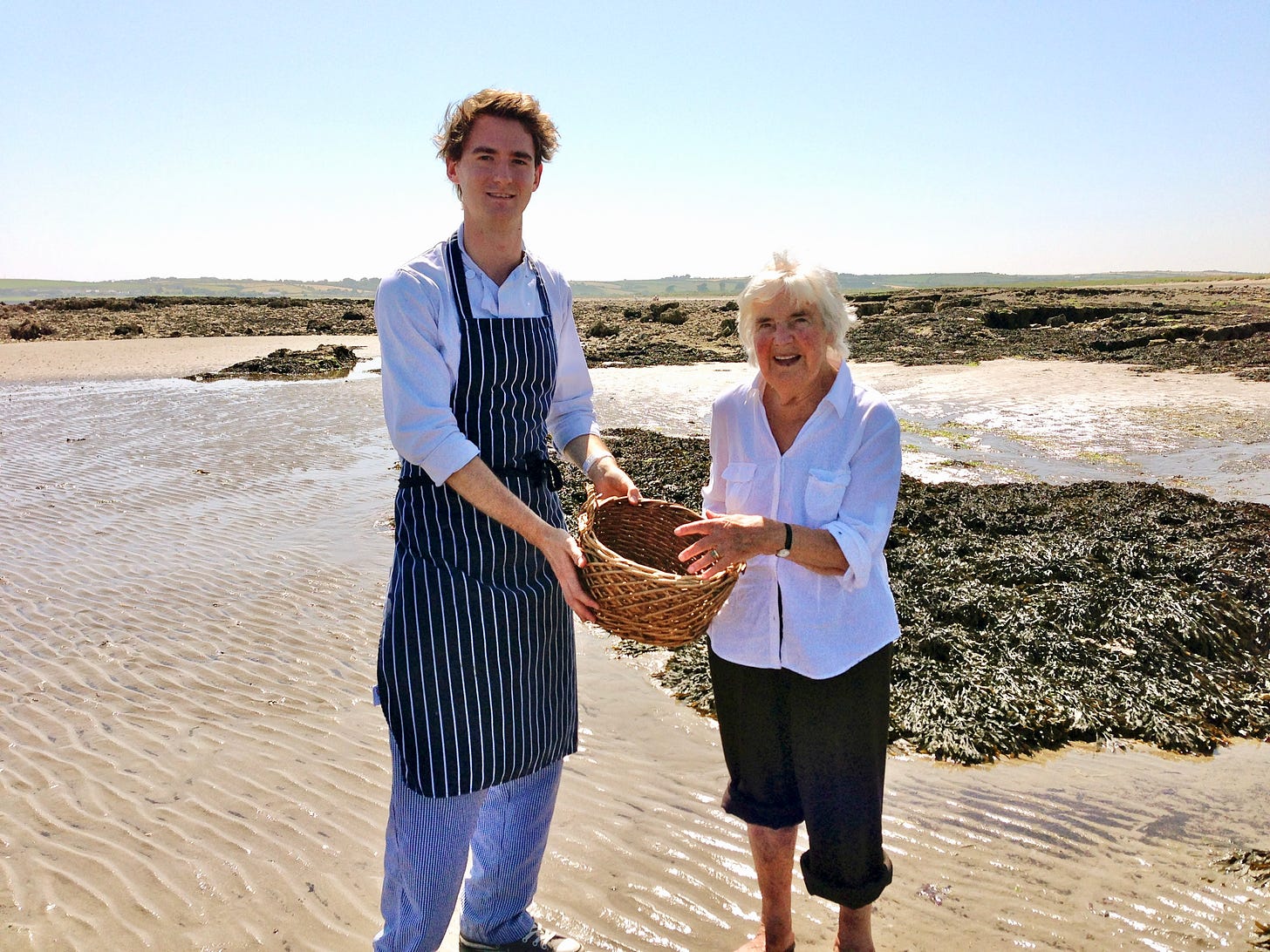
One of these dishes is Mrs Allen’s Carrageenan Moss pudding, a panna cotta adjacent dish that gets its wobble from seaweed. At Ballymaloe, it is a constant fixture on the menu and is often served with seasonal fruit. “It’s very traditionally Irish,” JR explains. “Mrs Allen taught me the skill of collecting seaweed. During the first two weeks of July, we'd jump in her car, go to the shoreline, and pick the seaweed at low tide.” When enough seaweed was collected, they would return to the house to prepare it. “You'd hope the rain would fall at the right time and the sun would dry it out.” Once dried, the chefs bring it into the kitchen, simmer it in milk, sweeten it, and add vanilla. “Not only do I love the dessert,” JR explains, “I love the process. I love that [Mrs Allen] taught me how to make it. It's frugal, it's got culinary heritage.”
On writing Ballymaloe Desserts, JR explains how he and his editor at Phaidon wanted the book to “feel like a breath of fresh air.” I can tell you confidently: He has succeeded. The book is beautiful, it feels modern but has all the classic desserts you could dream of. The styling is simple but inspiring, and filled with the sorts of recipes that you would make for friends, for dinner parties, for celebrations. Because of the way Ballymaloe House approaches desserts, JR explains that “these aren't restaurant dishes that have been reformulated … Sometimes we literally make a single bread and butter pudding … and it'll look just like one in the book”, which makes this a truly approachable and valuable selection of recipes for home cooks and professionals alike.
Along with stories of Mrs Allen and the other chefs that made him, the book feels timeless and transporting. “I call my entry into the pastry world the scenic route.” It’s true - JR’s route is a winding one, brimming with hard work, commitment and, ultimately, huge love for his craft. JR puts it simply: “I’m a firm believer and if you don't make an investment, you don't get a return. I say that to people who come and work in Ballymaloe now ... Some people really do want to set roots down, and for those that do, there is an enormous return.” He continues, “I've felt it. So, you know, I'm proof of the pudding.”
Ballymaloe Desserts is out now. Follow JR’s pastry adventures on Instagram, here.
—
JR’s world of Meringue Gâteau
I’m thrilled to be sharing an excerpt from ‘Ballymaloe Desserts’ for today's recipe. There’s so many brilliant recipes in there, it was genuinely hard to pick. As I was flipping through I was struck by the sight of JR’s Meringue Gâteau(s). What is a Meringue Gâteau? Well it’s somewhere between a pavlova and a dacquoise - I’d never seen anything quite like it. Sometimes I think a little too traditionally and I can’t imagine eating meringue outside of the summer season, but these gâteaus really opened my mind. Just look at this stunner: A two-layered walnut meringue with pears and cream, perfect for the shorter days when pears are at their peak.
JR, like me, is fanatical about pears: “They have the most mystery!” he exclaims, “Some ripen quickly, some have to be stored in cold storage, then ripen later. Those that you harvest later, like in October, November, you generally don't use until January. Those that you pick in August you use almost straight away, tend to be so fruity and fragrant, and you know, you make the same dish or the same recipe, but as the pairs change, the flavor of the dish changes.”
Fruit desserts are always his favourite because, in his words, “when they're good, by golly, like they blow you away.” Too right, JR!
Before we get to the recipe, I decided to get deep on the development of these gâteaus with JR in Q&A form, figuring out the best way to make, store and prep these at home:
JR on making meringue
Where do you stand on the old vs. fresh egg whites for meringue?
JR: I tend not to get too caught up on the age of the egg whites for meringues, and I use whichever I have on hand; I find that both day-fresh egg whites, and indeed whites that are a few days old, both whip up to a pleasing meringue, when using a stand mixer on full speed. I do, however, make sure eggs are free-range (and organic when possible) irrespective of age! And I like to start with room-temperature eggs. If you store eggs in the fridge, allow them to come to room temperature before making meringue.
Talk to me about stabilisiers: In your opinion, when are they necessary?
JR: I tend not to add stabilisers to meringue, though many cooks will add a pinch of cream of tartar (tartaric acid). The theory is that the acidic nature (low pH) of the cream of tartar aids in achieving a perfect texture. I find that a good stand mixer on high speed will whip a glorious, glossy and stiff meringue without any need for this extra ingredient. Though if you wish, feel free to add a pinch, it will do no harm. A squeeze of lemon juice, or even vinegar, can also be added to meringue; both have a similar effect as cream of tartar. Though I should mention, if preparing meringue in a copper bowl, do not add any form of acid to the ingredients: the acid will draw an unappetizing and unwanted amount of the metal into the mixture.
Pavlova is the one meringue dessert where I perceive a real benefit to adding acid, as it plays a part in creating the auspiciously marshmallow-like interior texture that in many ways defines the dish.
What are your top tips for baking meringue?
JR: Many of the meringues we bake at Ballymaloe take on a little colour in the oven. This gives the meringue a lovely flavour that I find to be much more appealing than any ice white alternatives that tend to taste of little more than the sugar they contain. I always bake meringues in a conventional (non-fan) oven on their own; moisture from any other item might spoil the meringue. To prevent cracking and crazing, I cool meringues slowly after baking. At Ballymaloe we use two main methods for baking meringues:
1. Bake at a moderate temperature for a relatively short amount of time – usually at 180°C/350°F/Gas Mark 4 for 15–20 minutes. The aim here is for the meringue to have a marshmallow-like centre and a thin crisp exterior. Meringue baked this way is perfect for rolling into a roulade.
2. Bake at a low temperature for a long amount of time – usually at 130°C/265°F/ Gas Mark ½ for 1 hour or longer. The aim here is for the meringue to lift easily away from the paper it is baked on. If you reduce the temperature to 100°C/210°F/Gas Mark 1⁄4, the meringue will remain completely white, but as mentioned above, the meringue will have less flavour and take longer to cook through.
In the meringue introduction, you mention icing sugar being good for meringues which I’ve never considered before - it’s very clever! Please could you tell me more about that?
JR: Some of the recipes do indeed use icing sugar, take the Irish Coffee Meringue Gâteau for example. I like to use icing sugar in this recipe because it gives the meringue the finest texture possible. And because Icing sugar usually contains 3 per cent starch, such as cornflour (cornstarch), to prevent it from caking, I find the presence of the starch results in an extra crisp exterior. This is a useful characteristic if the meringue is to be layered into a gâteau with a creamy filling in advance and held for some time. While the cream will soften the meringue on the inside of the gâteau, the exterior will remain crisp and contrasting.
When you are creating desserts, how do you decide when to use french vs. swiss. Vs italian meringue?
JR: For most of the meringue desserts I make at Ballymaloe I use French meringue. It is easy to prepare and nice to handle - room-temperature egg whites are whisked with room-temperature sugar. Once French meringue reaches stiff peaks it must be shaped and baked soon after, as it does not hold well over time. Once baked through, the meringue holds perfectly and can be filled sometime later.
Though on some occasions, I want to make a dessert where the meringue will not have the opportunity to bake through, or perhaps I want to hold the dish for some time before it is cooked. On these occasions, I opt to make Italian or Swiss meringue. Both are very stable and can hold for some time without wilting. This is a particularly useful characteristic when making a dessert such as Baked Alaska, where the meringue will not have an opportunity to cook through, due to the cold ice cream centre, and the dish may also have to hold in the freezer for some time before it is baked.
JR on pears
How do we pick a perfect pear? What are your favourite varieties?
JR: Pears are perhaps my favourite fruit. When perfectly ripe, they are glorious. Though catching a pear at the ideal moment is not easy. The best way to test a pear for ripeness is to very gently apply pressure to the neck of the fruit: if it gives just slightly it is ripe; if it is soft it is past its best.
Some of my favourite varieties include: Doyenne du Comice and Conference, both are excellent all-rounders and widely available. Other varieties such as Beurre Hardy, Concord, Josephine de Malines (a particular favourite) and Williams pears (also known as Williams’ bon Chrétien, or Bartlett in the United States) also work very well in desserts where the fruit is being cooked, these varieties also eat well out-of-hand when ripe and fragrant.
Should we store our pears at room temperature or in the fridge?
JR: When I buy pears I choose firm fruit and ripen them in a warm spot in my kitchen. When harvesting pears, though, it's a different story! Pear variety that are harvested early in the season, such as those that are ready to pick in August, ripen and develop full flavour within a few days of picking, they need only be held at room temperature, while varieties that are harvested later in the season - late October and into November in some cases - are best stored in a cool place where the pears slowly ripen and develop their flavour over several weeks.
How do you prevent the pears from oxidising and going brown in this dessert?
JR: If you plan on holding this meringue gâteau for some time before serving it, the pears can be tossed in lemon juice after they are peeled and sliced, before arranging them on top of the cream. Though it might surprise you how little the pears actually oxidise even if you don’t add any lemon juice at all!
Your book has a whole chapter about fruit and how to prepare it - it’s beautiful. What is the ideal pear for poaching vs. pear for eating?
I like to use pears at the same point of ripeness for both poaching and eating. This will contradict what many cooks say on the subject, I know! All I can say is that from much trial and error I have come to realise there is little point in poaching rock-hard pears; yes, they will soften, but where will the flavour come from if they are not properly ripe and fragrant to begin with? Try poaching ripe pears and you’ll never look back.
Would you recommend poaching pears for this gâteau, and if so, what are your favourite aromats for poaching fruit?
I do love to poach pears, I particularly like to pair them with flavours such as saffron and cardamom, or even sweet geranium leaves. However, when it comes to this meringue I much prefer the texture of fresh pear, and when the flavour combines with the walnut it pushes the flavour forward in the most pleasing way.
Serving / making ahead
In the book, you have examples of three layered meringue gateaus - what’s the tallest meringue gateau you’ve ever built? Is there a limit?!
JR: Good question! I think there is potential to have a lot of fun playing around the number of layers in a meringue gateau. I must admit I haven't actually tried to go any higher than 5 layers! But I look forward to seeing if any of your readers go beyond this. Please share if you do :-)
What is the key to cutting the meringue gâteau?
JR: This is always the tricky bit! The key is to make sure the layers of meringue are not too thick, in which case the cream will often each layer just a little making it easier to cut. Though do prepare yourself, by its very nature meringue will shatter, which is part of the fun in my opinion. So I suggest you embrace it and enjoy the show.
How far in advance can we assemble the gâteau and how can we store it? How does the texture change?
JR: I like to eat this gâteau within an hour or so of assembling it, though it will hold well for several hours in the fridge. If it sits overnight in the fridge the cream will soften the meringue too much and the gâteau will lose its charm and good looks!
Which parts can be made in advance? If making in advance, what is the best way to store meringue discs?
JR: The meringue disks can be made days or even a week or two in advance. The important thing is that the meringue is baked fully through, this is not the place for a soft-centre, and when completely cooled the disks can be stored in an airtight box or tin. Assembling the gâteauthen takes relatively little time.
Recipe: Walnut Meringue Gâteau with Pears
An excerpt by JR Ryall from ‘Ballymaloe Desserts’
Meringue gâteau is a very useful way to serve fresh fruit as an elegant dessert. In this recipe, the walnut in the meringue encourages the ripe pear to taste its best, and of course if you are eating meringue, you must also have cream.
Pears are tricky to grow, tricky to ripen and tricky to catch at the perfect moment! There are many pear trees at Ballymaloe and they grow well against the comfort of a south facing wall. The best and most useful of these pears are the later varieties, which can be stored into the winter and bring a freshness to the dessert trolley during these months. Josephine de Malines is one of the newer varieties planted in our garden and is harvested in late October; it crops well and the fruit stores well, and the pears are very beautiful. Whichever variety of pear you choose, it is important to use fragrant and ripe fruit in this dish.
Serves 6
For the meringue
2 large (US extra-large) egg whites
110 g/4 oz (1⁄2 cup plus 1 tablespoon) caster (superfine) sugar
50 g/2 oz (scant 1⁄2 cup) chopped walnuts
To assemble and decorate
–2 ripe dessert pears
225 ml/8 fl oz (1 cup) whipped cream
5 walnut halves
Method
Preheat the oven to 130°C/250°F/Gas Mark 1. Cover a baking sheet with baking paper and, with a pencil, draw out two 19-cm/71⁄2-inch diameter circles on the paper. Flip the paper over so the pencil is on the underside.
Check that the bowl of your electric stand mixer is dry, spotlessly clean and free from grease. Place the egg whites and sugar into the bowl and whisk until the mixture forms stiff peaks, about 10 minutes.
Fold in the chopped walnuts and, using the drawn on circles as a guide, evenly spread onto the baking sheet in two circles. Bake for about 1 hour, until crisp and set. When the meringue is cooked it will lift easily away from the baking paper. Allow to cool completely.
To assemble: Put one of the meringue circles on a serving plate. Peel the pears, remove the core and slice into 1-cm wide pieces. Spread or pipe most of the whipped cream over the meringue and arrange the slices of pear on top of the cream. Put the second circle of meringue on top and lightly press down.
Decorate the top with rosettes of the remaining cream and the walnut halves.

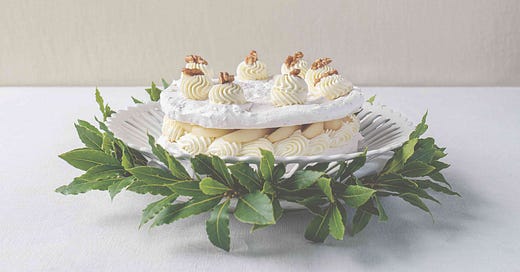



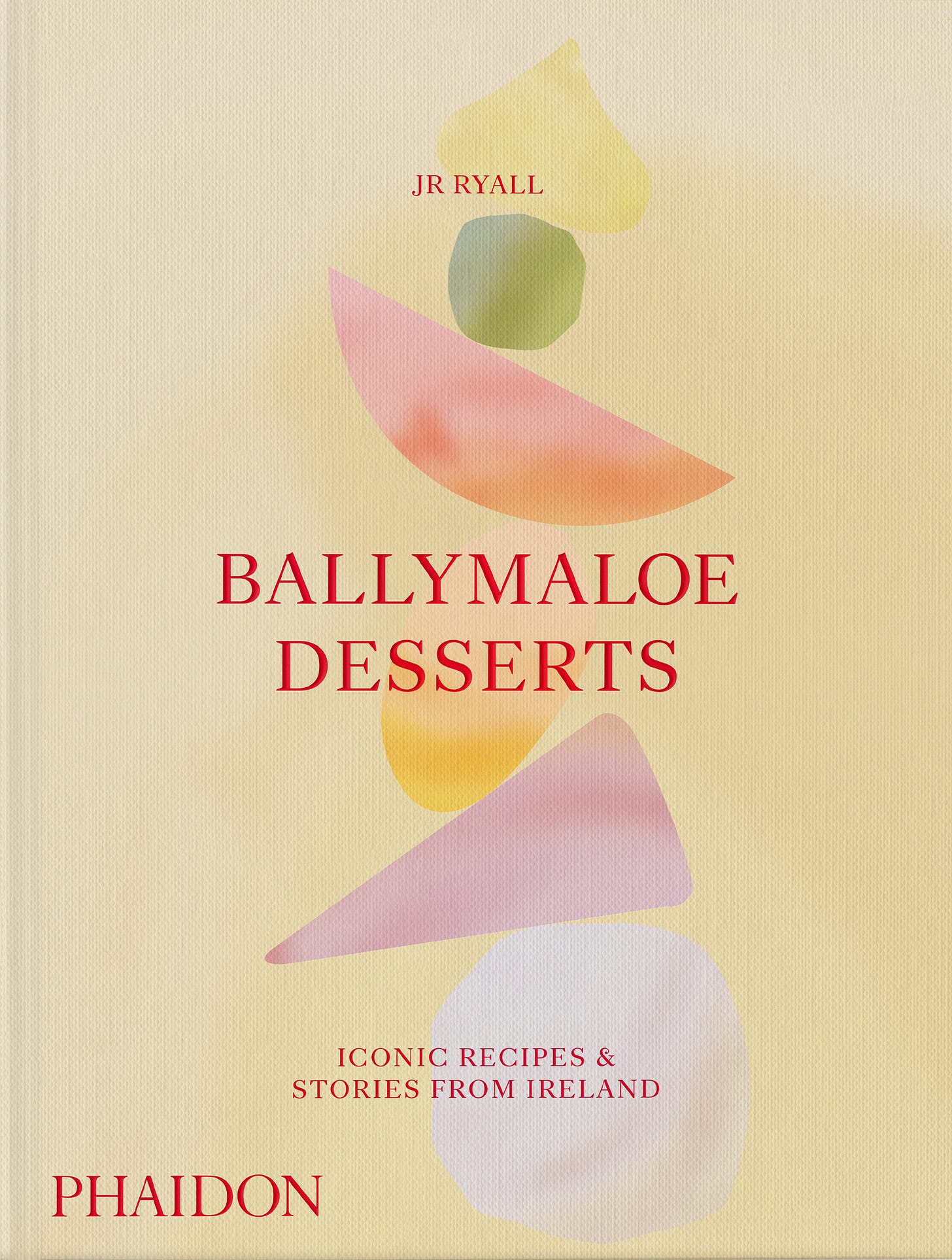
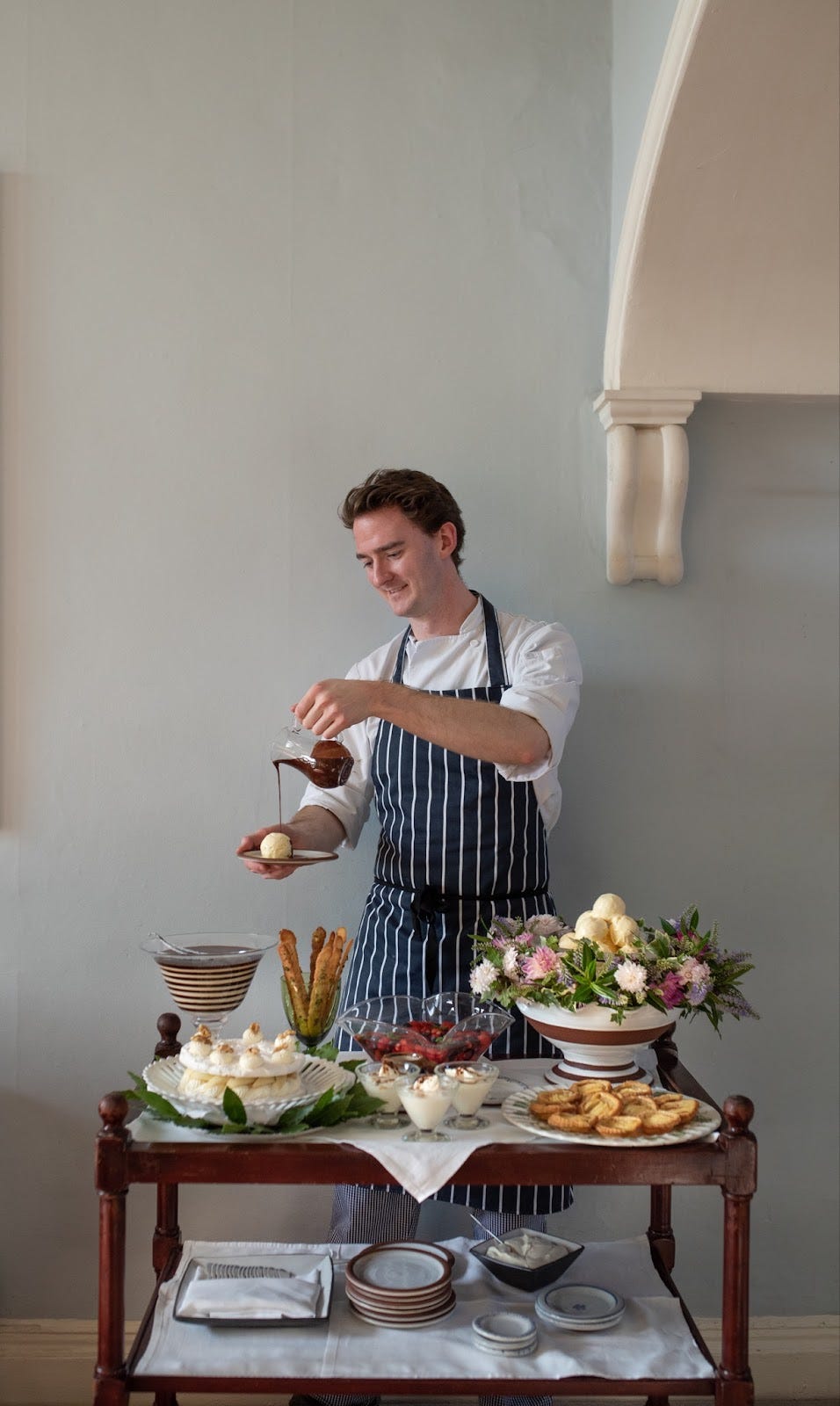
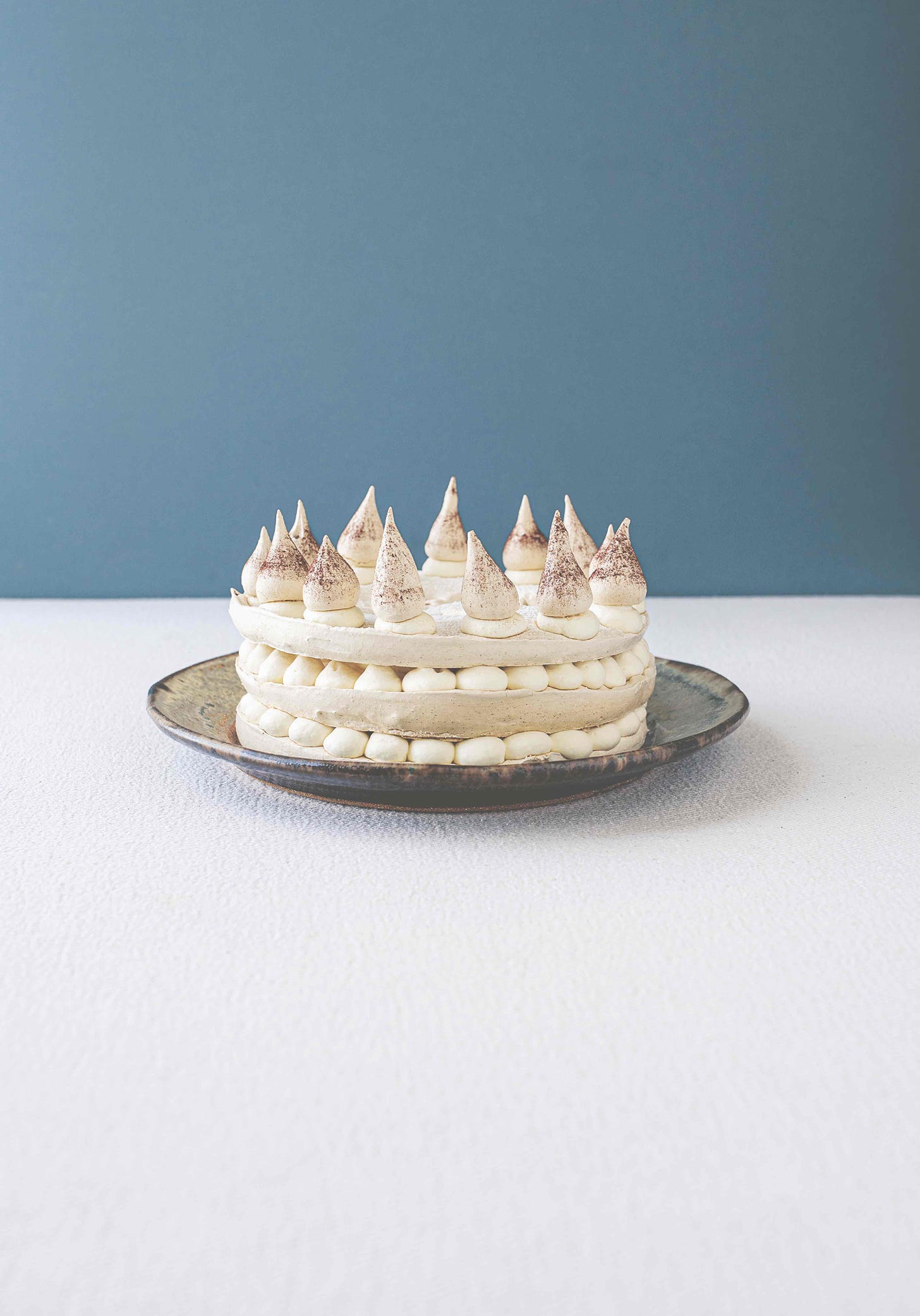
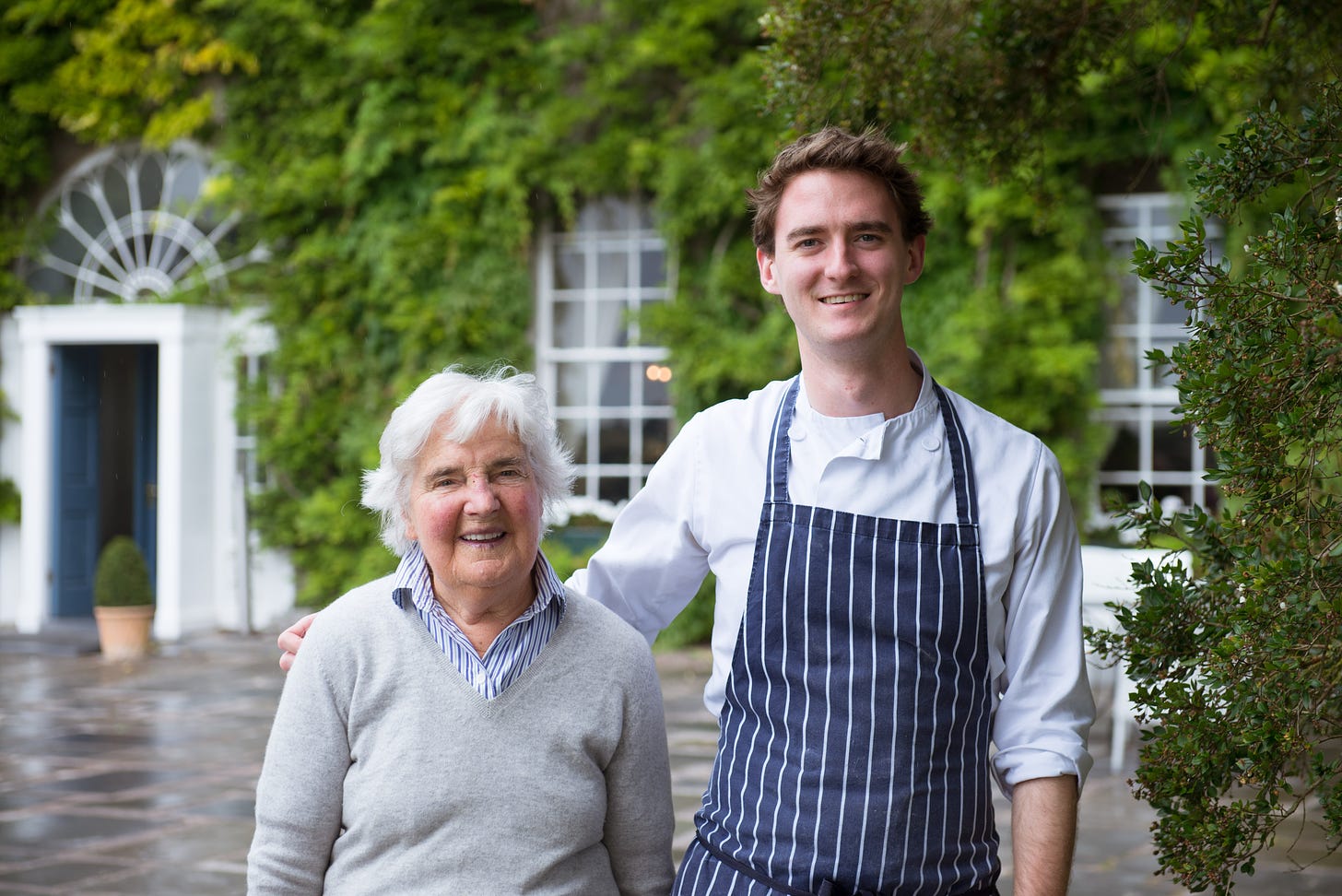
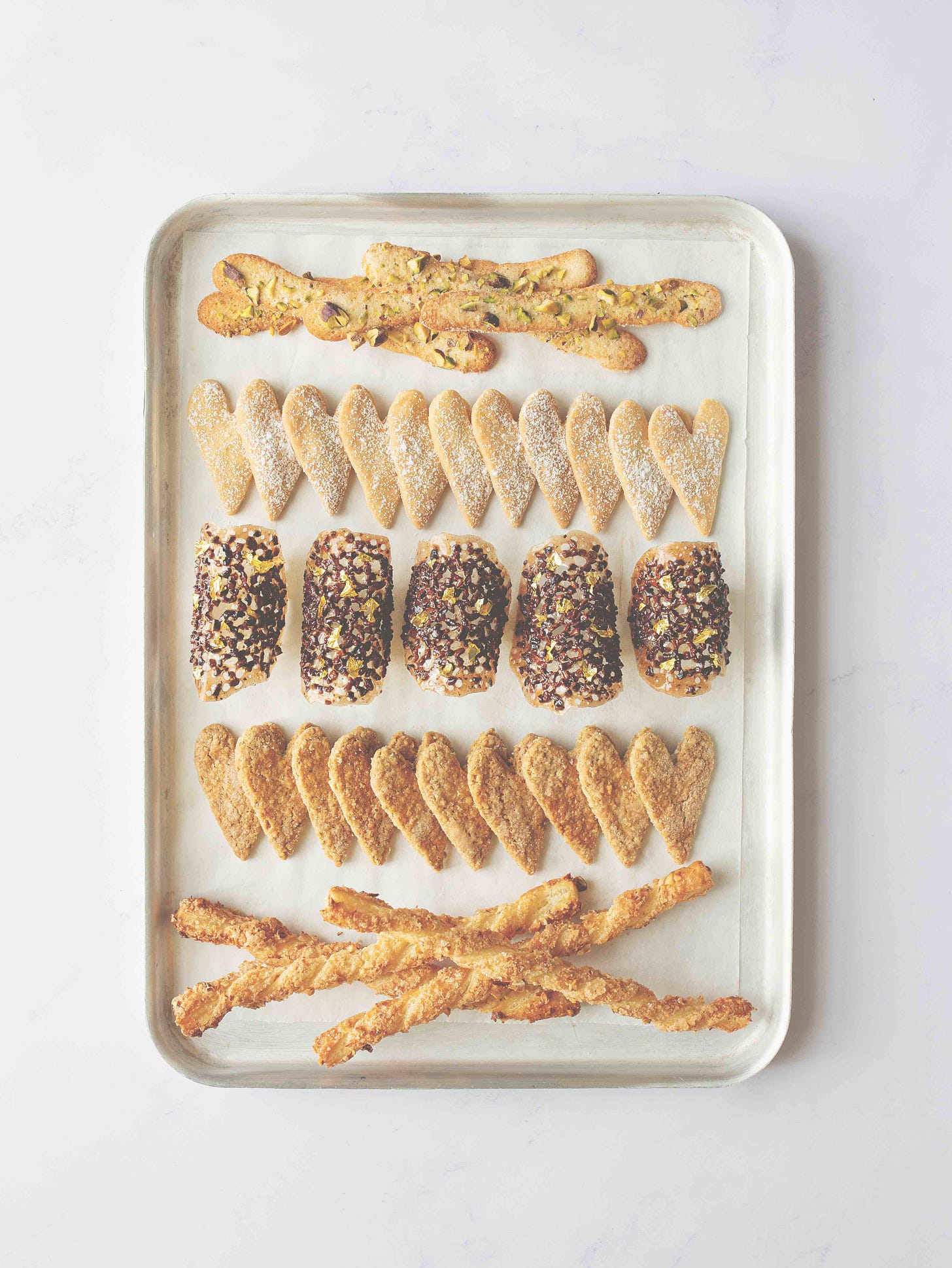

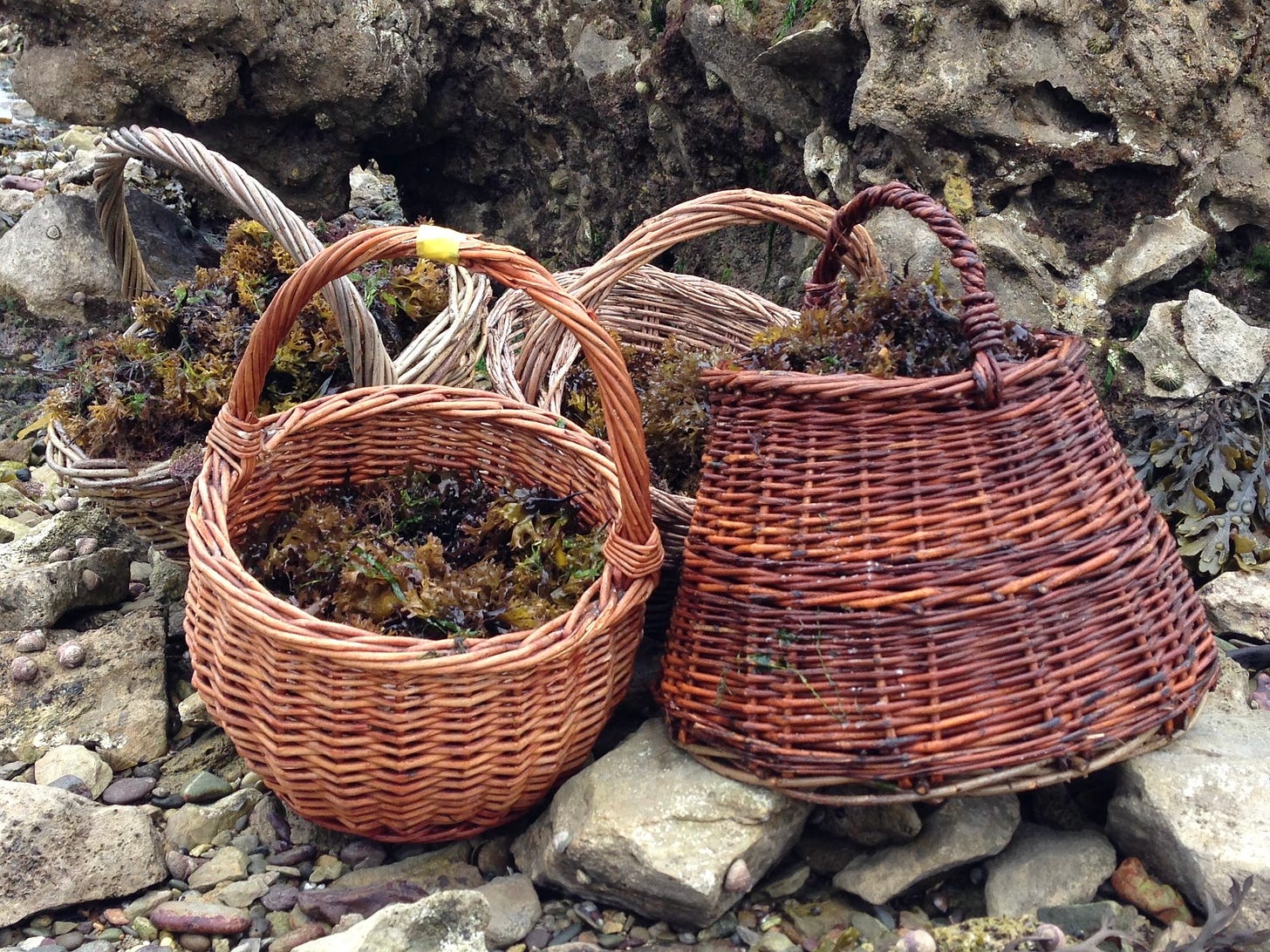


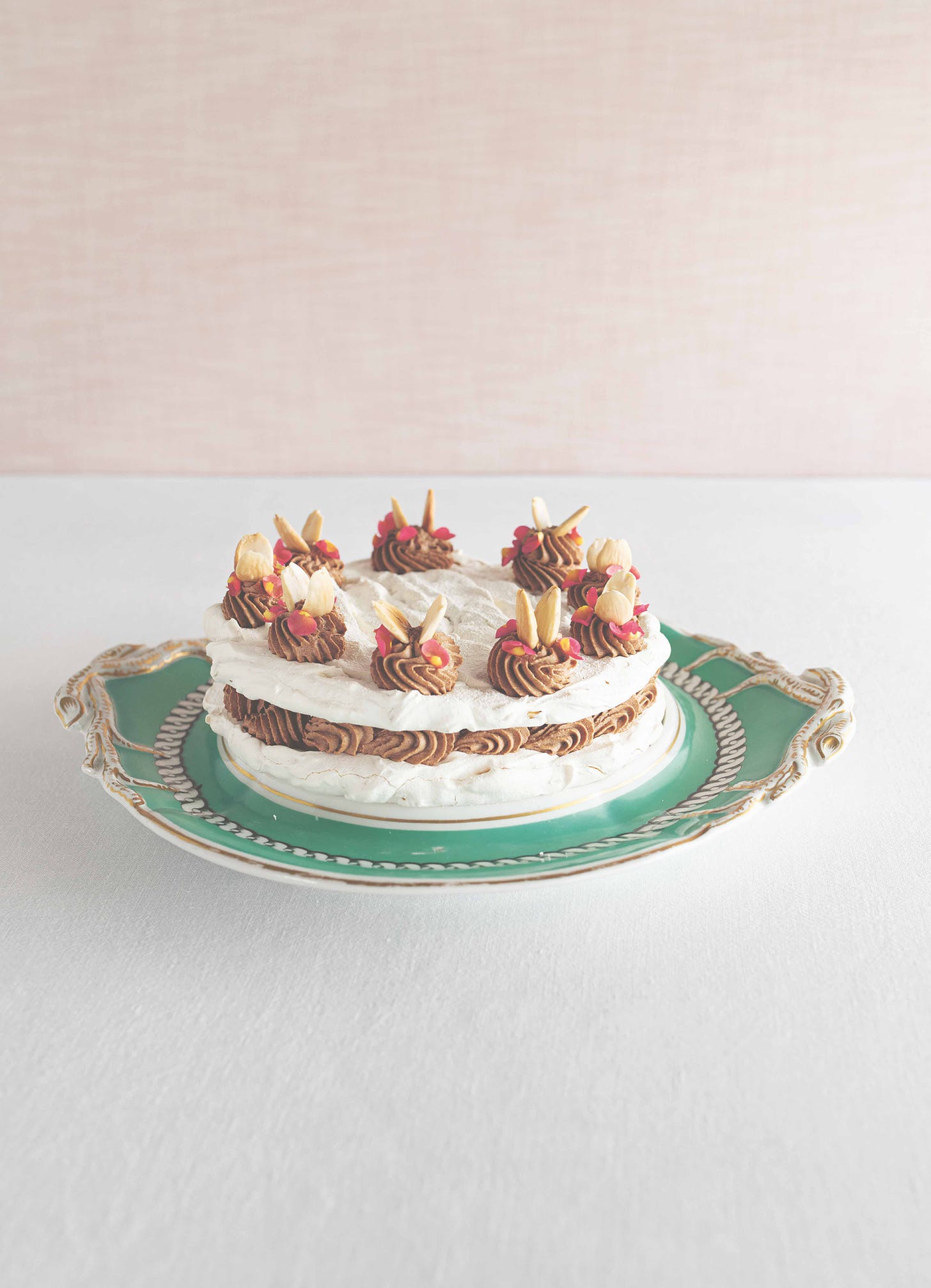
It's a shame you partnered with ballymaloe. Maybe you just didn't know. They turned a blind eye to child pornograohy, unapologetically. They shouldn't be operating today. They have a convicted sex offender, Darinas husband, still working there. They shouldn't be in business, they shouldn't be celebrated. They should be out of public view, for shame. All information is available, please. Don't skin over the truth. Children deserve better than this.
Really enjoyed reading this, what a beautiful story :)